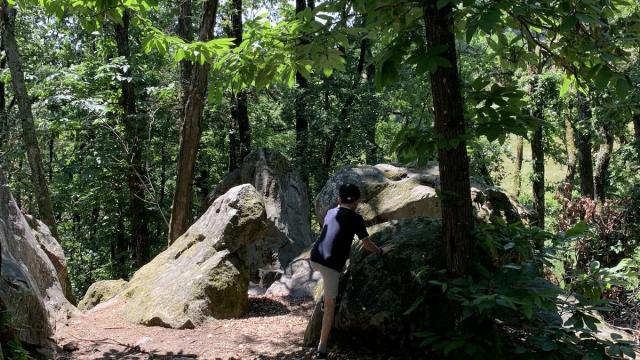 Lesrochesquidansent 03 Pleincoeur Tourism©2014 Sbridot
Lesrochesquidansent 03 Pleincoeur Tourism©2014 Sbridot Lesrochesquidansent 03 Pleincoeur Tourism©2014 Sbridot
Lesrochesquidansent 03 Pleincoeur Tourism©2014 Sbridot Lesrochesquidansent 03 Pleincoeur Tourism©2014 Sbridot
Lesrochesquidansent 03 Pleincoeur Tourism©2014 Sbridot Lesrochesquidansent 03 Pleincoeur Tourism©2014 Sbridot
Lesrochesquidansent 03 Pleincoeur Tourism©2014 SbridotIt is in a wood near Saint-Barthélémy-de-Vals that the dancing rocks stand. Geologically speaking, they are sandstone rocks with a high concentration of quartz, irregularly hardened by a siliceous cement sometimes forming chalcedony concretions. Remaining protruding when the surrounding sands were dragged away by erosion, they form on the wooded hillside of chestnut and oak trees a natural assembly of 51 large blocks arranged in three roughly concentric circles (hence its official name of “Cromlech-de-la-Roche-qui-danse”, also known as the cromlech of Douévas) that extend over nearly 6 hectares.
There are recognizable menhirs, a wobbly stone, an altar, dolmens, a cromlech*, … These are natural geological curiosities, but some believe the site was a place of Druidic worship. The place was occupied at least fromthe Bronze Age. We still have some burials found around it, some of which date from the Celtic period, as mentioned by Monsieur Lacroix in the 1866 Bulletin d’archéologie et de statistique de la Drôme.
 Dancing Rocks
Dancing Rocks Lesrochesquidansent 03 Pleincoeur Tourism©2014 Sbridot
Lesrochesquidansent 03 Pleincoeur Tourism©2014 SbridotLegends relating to the Roches are numerous: one reports that at Christmas and St. John’s Day, fairies gathered there to invoke the spirits according to specific rites making the rocks vibrate, and that a child saw them move after attending a service.
Another attributes them to the presence of Gargantua, whose footprint remains in the rock. Yet another tells of a baby who disappeared during the 12 strokes of midnight on Christmas night and was found in the same place a year later without having aged. But the most persistent legend makes it a place frequented by the druids.
What is certain is that the place is very strong in telluric and cosmic energy. The telluric currents don’t even need to be measured, the twisted trees tell us!”
The Roches qui dansent, it is the essential site for climbing in Porte de Dromardeche. Here, what seduces sensation lovers is first of all this magical place, where never boulders have waltzed and where it is pleasant to climb in a shady place! No approach walk, quality boulders scattered in a pleasant forest, varied heights and from very easy to very difficult to satisfy climbers of all levels: come with family to climb at the Dancing Rocks!
 Lesrochesquidansent 02 Pleincoeur Tourism©2014 Sbridot
Lesrochesquidansent 02 Pleincoeur Tourism©2014 SbridotDiscover other nearby picnic areas
Book a nearby accommodation
.